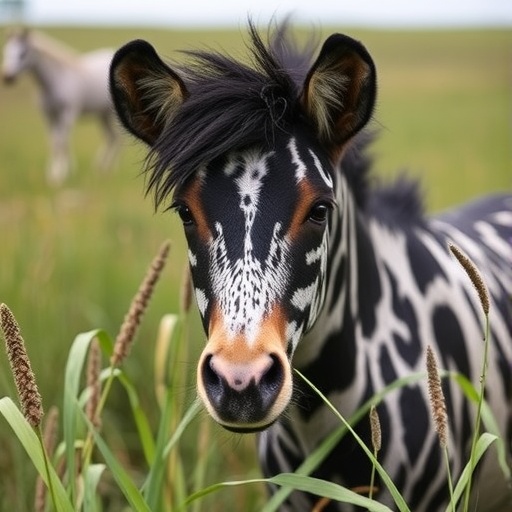In a groundbreaking study published in BMC Genomics, a team of researchers led by Kingsley et al. has unveiled new insights into the genetic factors underpinning insidious uveitis in Appaloosa horses, a condition that has long puzzled veterinarians and horse owners alike. This genome-wide investigation seeks to clarify the genetic predispositions that make some Appaloosa horses more susceptible to this debilitating eye condition, which can lead to severe vision impairment if left untreated. The study not only highlights the necessity of genetic understanding in animal health but also emphasizes the broader implications of genetic research in equine welfare.
At the core of this research is a meticulous examination of the Appaloosa breed, which is renowned for its striking coat patterns and unique genetic heritage. Insidious uveitis, characterized by a gradual onset of symptoms that can lead to blindness, poses significant challenges for affected horses. This condition’s insidious nature means that early detection is critical, yet often neglected until irreversible damage occurs. The study asserts that a deeper understanding of the genetic markers associated with insidious uveitis could facilitate better predictive measures, potentially revolutionizing veterinary practices concerning eye health in horses.
The researchers employed advanced genomic tools to analyze the DNA samples from a cohort of Appaloosa horses affected by uveitis and a control group free from ocular diseases. The genomic methodologies utilized in this research are at the forefront of veterinary science, combining traditional genetic mapping techniques with modern high-throughput sequencing strategies. These methods provided the researchers with a comprehensive understanding of the genetic variations associated with uveitis, allowing them to pinpoint specific alleles of interest.
Key findings reveal an intriguing correlation between certain genetic markers and the prevalence of insidious uveitis among Appaloosa horses. The team’s rigorous analyses identified chromosomal regions that exhibit significant associations with the disease, offering a new lens through which to view this complex condition. One of the striking aspects of the study is the revelation that these genetic markers may not only serve as indicators of risk but could also shed light on the underlying biological mechanisms that trigger uveitis in predisposed horses.
The researchers contextualized their findings within the broader framework of equine health and disease management. Their work emphasizes the need for preventative genetic testing in Appaloosa horses, which could serve to identify at-risk individuals before clinical signs manifest. By implementing such practices, breeders and veterinarians can work collaboratively to reduce the incidence of insidious uveitis, ultimately improving the quality of life for countless horses.
Moreover, this investigation underscores the importance of genetic diversity within horse breeding populations. The Appaloosa breed, known for its unique characteristics, has faced challenges related to genetic bottleneck effects. The study’s insights suggest that diversifying breeding practices could help mitigate the risks associated with heritable diseases like uveitis, thereby fostering healthier populations. The implications for breeding strategies are substantial, potentially steering breeders towards more informed decisions that prioritize genetic health.
In addition to its implications for Appaloosa horses specifically, the study serves as a vital contribution to the field of comparative genomics. By elucidating the genetic bases of a condition that shares common traits with similar diseases across animal species, this research paves the way for cross-disciplinary insights. The identification of genetic markers linked to uveitis may not only facilitate advancements in equine veterinary science but could also inform studies on ocular diseases in other mammals, including humans.
The researchers also call for further investigation into potential environmental factors that may exacerbate the genetic predisposition to uveitis. Understanding the interplay between genetics and external stressors could lead to more effective management strategies that integrate both genetic counseling and environmental considerations. This holistic approach could prove crucial in developing comprehensive care protocols for Appaloosa horses afflicted with uveitis.
Despite the many promising findings, the study acknowledges the complexity of uveitis as a multifactorial disease. While genetic predisposition plays a significant role, the interaction between genes, environment, and other biological factors cannot be overlooked. The research team emphasizes that further studies are necessary to fully understand the causative mechanisms behind insidious uveitis and to explore the potential role of additional risk factors.
The publication of this study marks a significant step forward in the veterinary understanding of insidious uveitis in Appaloosa horses. With the integration of genomic data into clinical practice, veterinarians are equipped with tools not previously available to mitigate the risk of this condition. This research heralds a new era in equine healthcare, where genetic testing and individualized care plans may soon become the norm, dramatically improving outcomes for horses affected by ocular diseases.
In conclusion, the genome-wide investigation led by Kingsley and colleagues sheds light on a critical aspect of equine health, particularly for those involved in breeding and caring for Appaloosa horses. Their comprehensive approach combines the latest in genetic research with practical applications in veterinary medicine, creating a pathway toward improved health management for a breed deeply beloved by equestrians everywhere. The insights gleaned from this study not only benefit the Appaloosa population but also contribute to a broader understanding of genetic health in horses, which could ultimately enhance equine welfare on a global scale.
As the research community continues to dissect the findings presented in this study, the hope is that the knowledge gained from investigating insidious uveitis will trigger a wave of innovations in genetic research and veterinary care. With the right focus and resources, the future looks bright for preventing and controlling this mysterious condition that has challenged the Appaloosa breed for generations.
Subject of Research: Genetic factors associated with insidious uveitis in Appaloosa horses.
Article Title: A genome-wide investigation of insidious uveitis in Appaloosa horses.
Article References:
Kingsley, N.B., Sandmeyer, L., Dwyer, A. et al. A genome-wide investigation of insidious uveitis in Appaloosa horses.
BMC Genomics 26, 904 (2025). https://doi.org/10.1186/s12864-025-12099-3
Image Credits: AI Generated
DOI: 10.1186/s12864-025-12099-3
Keywords: Appaloosa horses, insidious uveitis, genetic factors, BMC Genomics, veterinary science, equine health, genome-wide association studies, preventive measures, breeding strategies.




